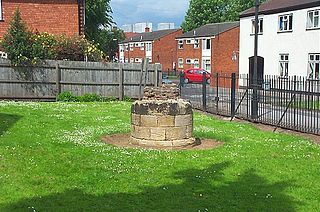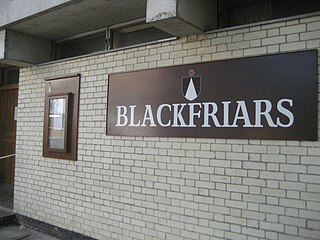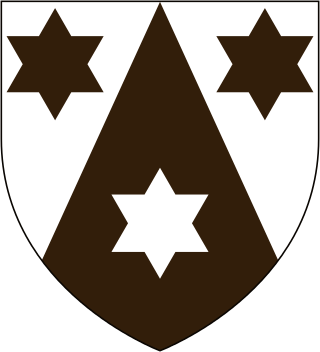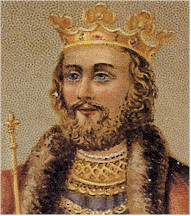Blackfriars is in central London, specifically the south-west corner of the City of London.

Blackfriars is a restored Grade I listed 13th-century priory in Newcastle upon Tyne, Tyne and Wear, England, located in the city centre, close to the city's Chinatown.
The Black Friars of Shrewsbury is a 2005 short historical book by Paul Marsden, the former Shrewsbury MP, about the Dominican friars who arrived in Shrewsbury, England, in 1230 and built a church, cloisters, Lady chapel and series of outbuildings.

Blackfriars, Gloucester, England, founded about 1239, is one of the most complete surviving Dominican black friaries in England. Now owned by English Heritage and restored in 1960, it is currently leased to Gloucester City Council and used for weddings, concerts, exhibitions, guided tours, filming, educational events and private hires. The former church, since converted into a house, is a Grade I listed building.

Lenton Priory was a Cluniac monastic house in Nottinghamshire, founded by William Peverel circa 1102-8. The priory was granted a large endowment of property in Nottinghamshire and Derbyshire by its founder, which became the cause of violent disagreement following its seizure by the crown and its reassignment to Lichfield Cathedral. The priory was home mostly to French monks until the late 14th century when the priory was freed from the control of its foreign mother-house. From the 13th-century the priory struggled financially and was noted for "its poverty and indebtedness". The priory was dissolved as part of King Henry VIII's Dissolution of the Monasteries.

St Andrew's Hall and Blackfriars' Hall or The Halls are a Grade I listed complex of former Dominican priory church and convent buildings in the English city of Norwich, Norfolk, dating back to the 14th century. They make up the most complete friary surviving in England. The complex is made up of several flint buildings. The centrepiece is St Andrew's Hall. The halls are now used for conferences, weddings, concerts, beer festivals and meetings. The maximum capacity is 1,200 people. It is one of the Norwich 12 heritage sites.

Blackfriars, Bristol was a Dominican priory in Broadmead, Bristol, England. It was founded by Maurice de Gaunt in 1227 or 1228. Llywelyn ap Dafydd, son of Dafydd ap Gruffydd, the last native Prince of Wales, was buried in the cemetery of the priory. Following the Dissolution of the Monasteries in the 16th century, surviving parts of the priory became a guildhall for the Smiths and Cutlers Company, the Bakers Company, a workhouse and then Bristol Quaker meeting house. In the 20th century, it has housed the local register office, a theatre company, and a restaurant.

Cambridge Blackfriars is a priory of the Dominican Order in Cambridgeshire, England. It was established in 1238, dissolved in 1538 and re-established in 1938. It continues to operate as a Dominican priory and, in 2000, became the novitiate house of the English Province of the Order of Preachers.

Blackfriars Priory was a medieval Dominican priory dating back to the thirteenth century. The remains of the priory, located in Hereford, England, consist of monastery ruins, a cemetery, and a stone preaching cross. The ruins are surrounded by a rose garden established by the local community in 1964.

Boston Friary refers to any one of four friaries that existed in Boston, Lincolnshire, England.
Blackfriars, Thetford was a priory in Norfolk, England, which belonged to the Dominican Order. It was one of several religious houses in Thetford closed at the time of the Dissolution of the Monasteries. The site is now occupied by Thetford Grammar School.
Guildford Friary was a medieval monastic house in Guildford, Surrey, England. It was founded c. 1275 by Eleanor of Provence, wife of Henry III and occupied a site of around 10 acres (4.0 ha) on the east side of the River Wey. It was dissolved in 1537.

Ipswich Blackfriars was a medieval religious house of Friars-preachers (Dominicans) in the town of Ipswich, Suffolk, England, founded in 1263 by King Henry III and dissolved in 1538. It was the second of the three mendicant communities established in the town, the first being the Greyfriars, a house of Franciscan Friars Minors, and the third the Ipswich Whitefriars of c. 1278–79. The Blackfriars were under the Visitation of Cambridge.

Blackfriars Leicester is a former Dominican priory in Leicester, England.

Nottingham Whitefriars is a former Carmelite monastery located in Nottingham, England.

Friar Gate Bridge, was made by Andrew Handyside & Co is a railway bridge at the end of Friar Gate in the centre of Derby in the East Midlands of England. It was made by Andrew Handyside & Co whose foundry was close to Derby's Handyside Bridge over the River Derwent. The bridge is a remnant of the GNR Derbyshire and Staffordshire Extension ; it formed the approach to Derby Friargate railway station. It is a grade II listed building.


















